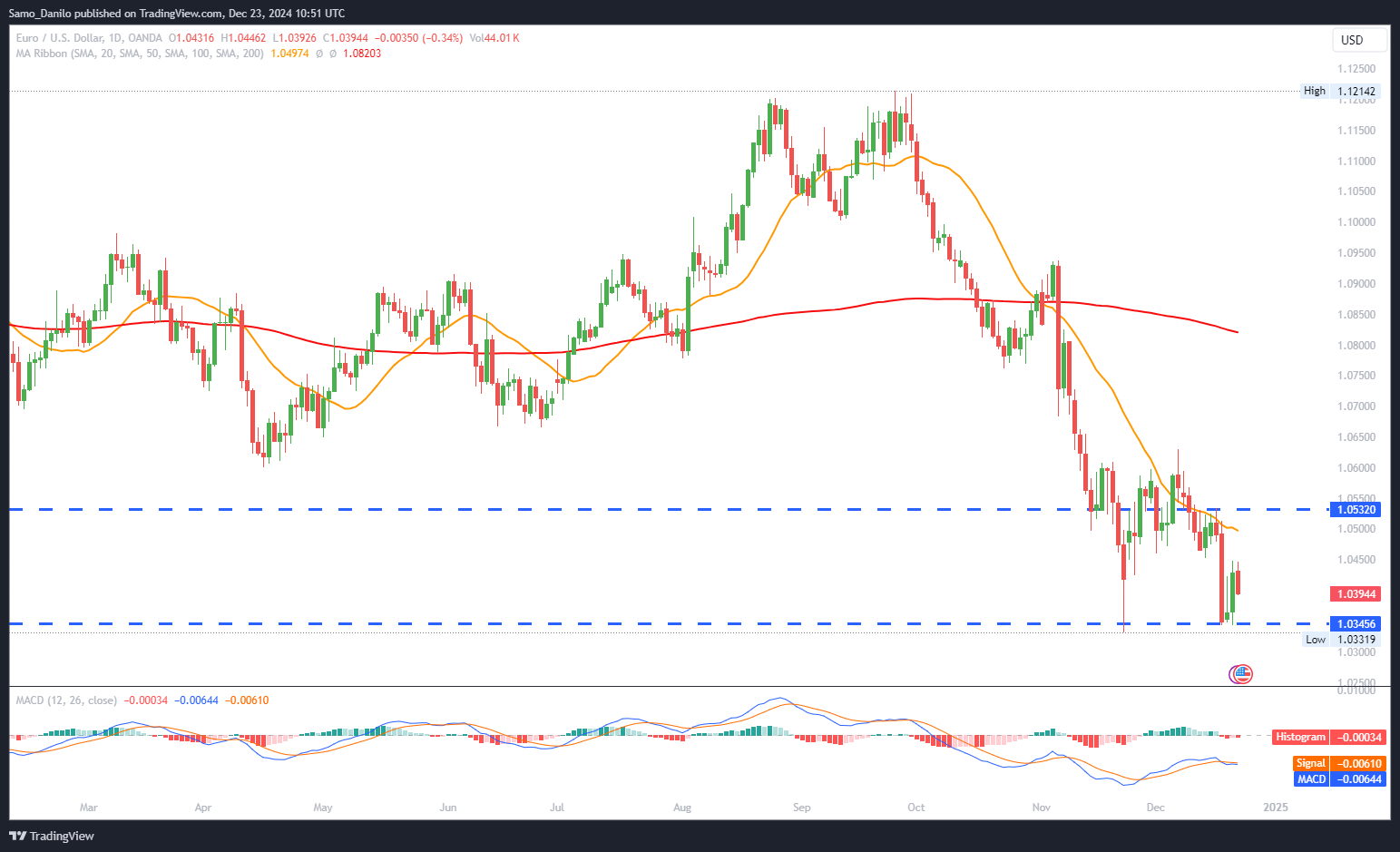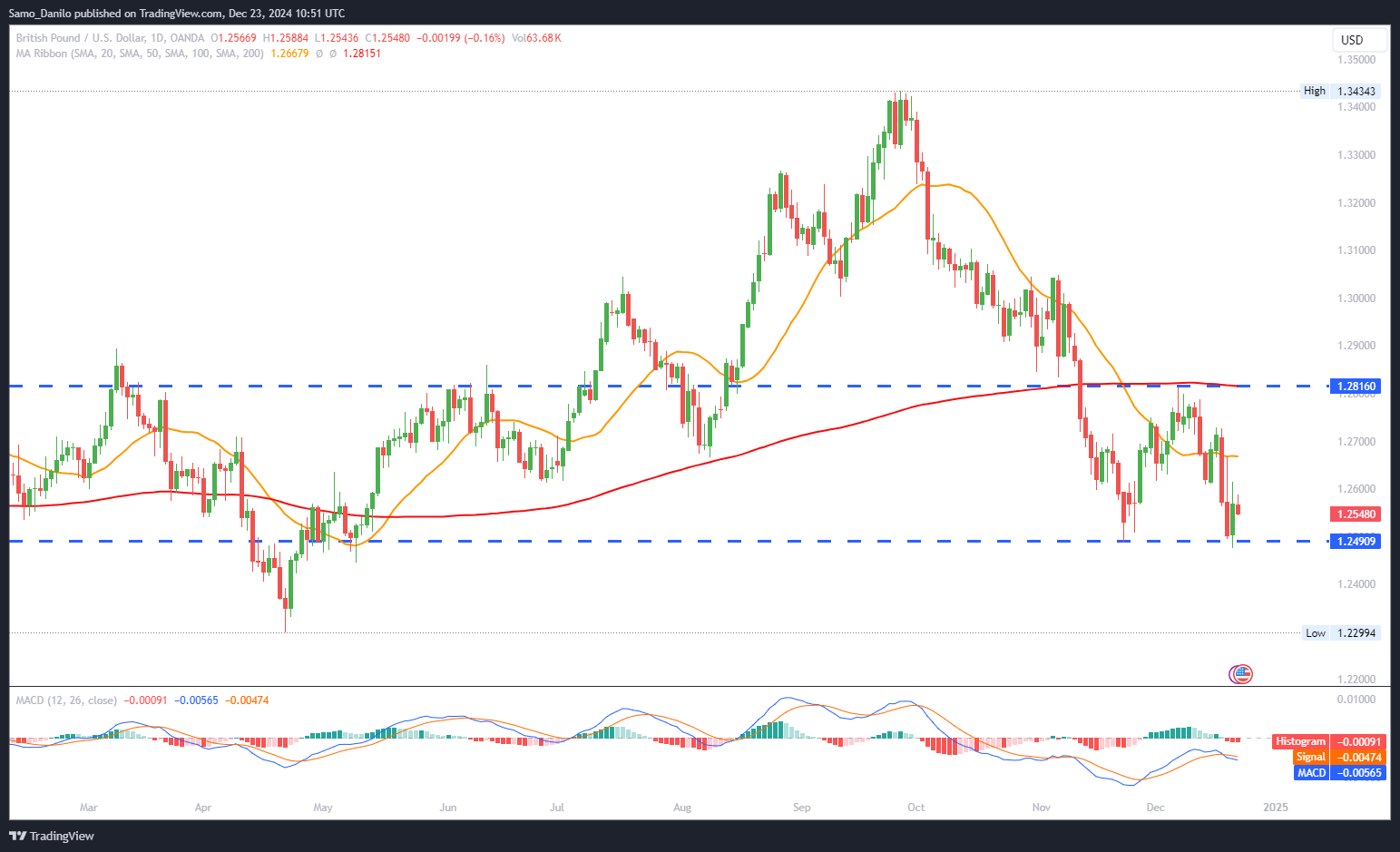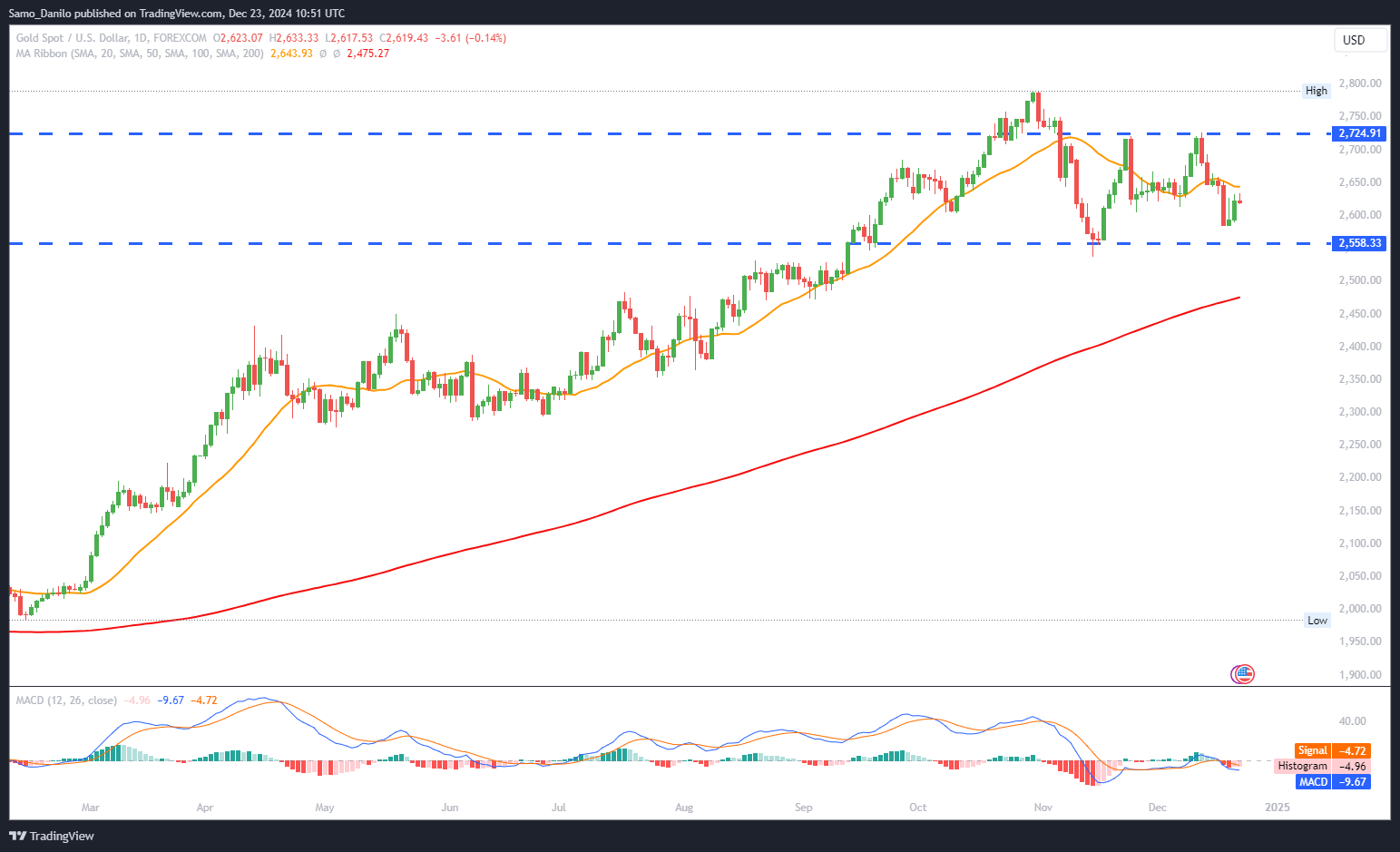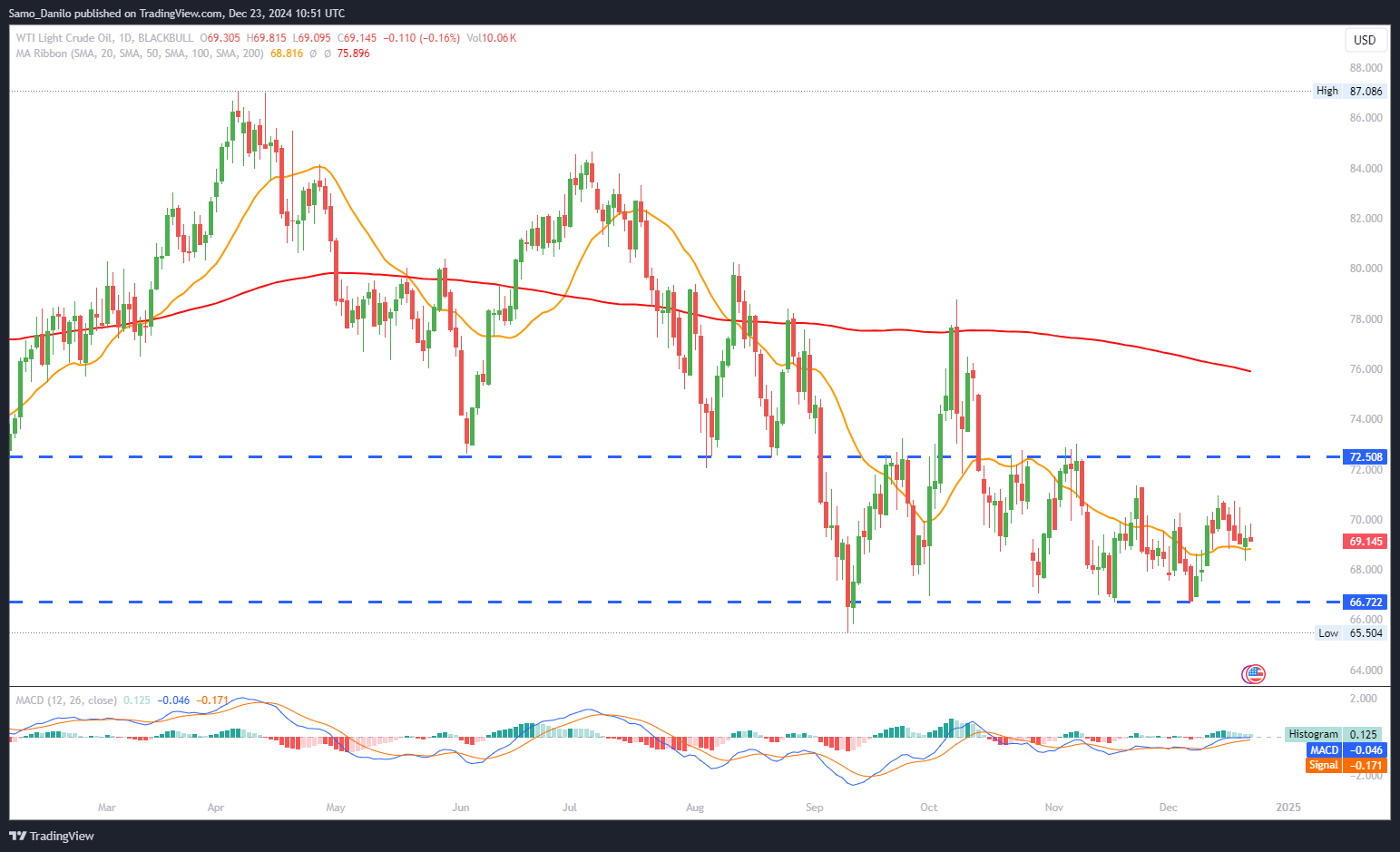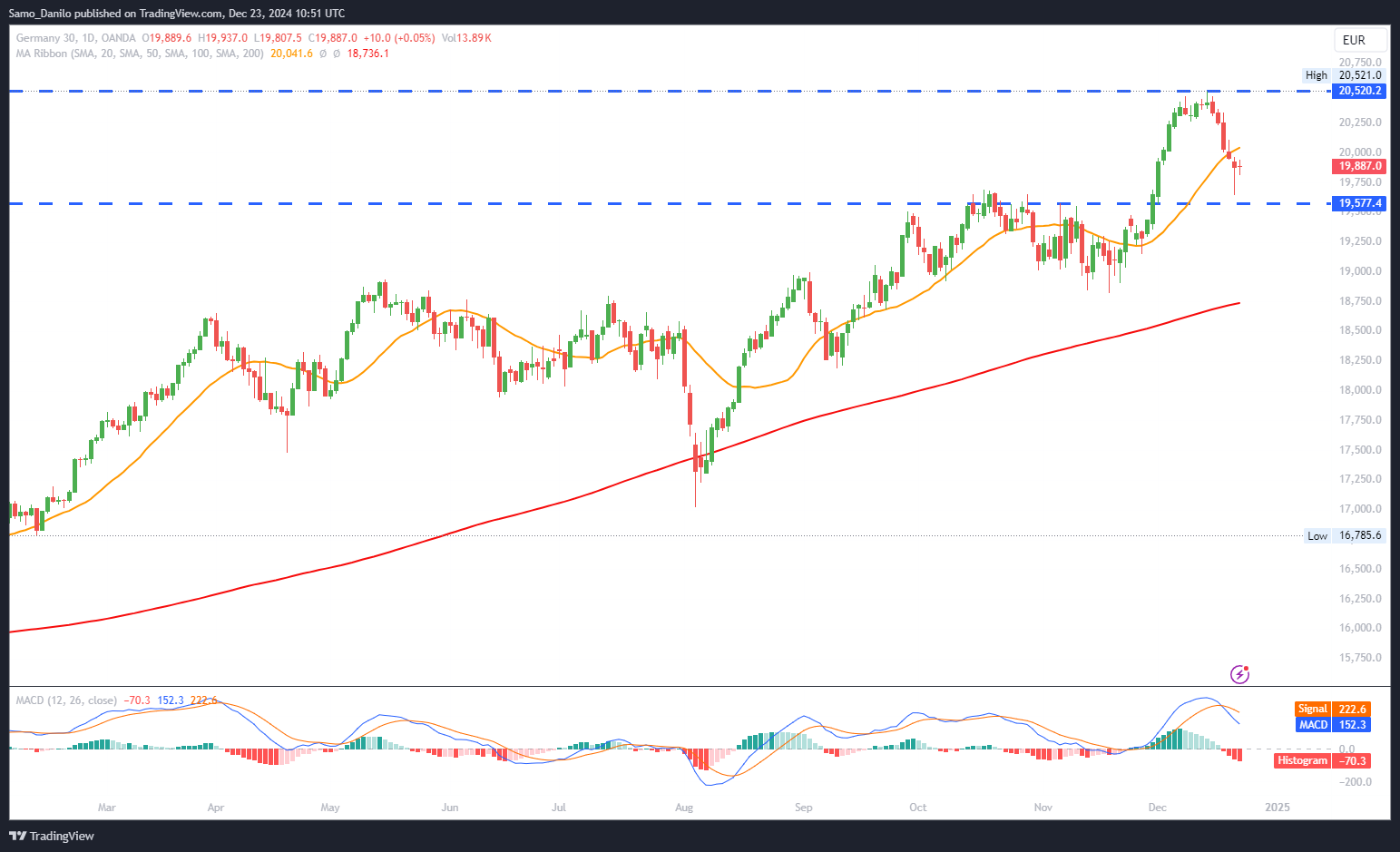EURUSD
- EUR/USD Price: The EUR/USD pair trades around 1.0400 during Monday’s European session. Thin trading conditions ahead of the Christmas holiday and a modest rebound in the US Dollar have kept the pair confined to a familiar range, reflecting subdued market activity.
- ECB Signals: ECB Governing Council member Boris Vujcic reiterated plans to further lower borrowing costs in 2025, aligning with the central bank’s ongoing easing stance. These remarks, shared via Bloomberg, emphasize the ECB’s strategy to counter deepening economic risks in the Eurozone.
- Lagarde's Confidence: In an interview with the Financial Times, ECB President Christine Lagarde voiced optimism regarding disinflation trends. Her comments suggest that inflation risks are under control, supporting the ECB’s dovish monetary policy trajectory.
- ECB Rate Cuts: The ECB reduced its Deposit Facility rate by 100 basis points this year, with an additional 100-bps cut anticipated for 2025. Policymakers aim to bring interest rates closer to the neutral level of 2%, aligning with market expectations and minimizing risks of inflation undershooting the 2% target.
- Consensus Among ECB Policymakers: A near-unanimous agreement among ECB policymakers supports consistent rate reductions until the neutral rate is achieved. This strategic approach seeks to balance economic stabilization while maintaining long-term price stability.
Closing statement: The EUR/USD pair remains range-bound amid holiday-induced thin trading and a modest USD rebound. With the ECB firmly committed to further easing in 2024-2025, market attention will focus on upcoming economic data and developments influencing Eurozone growth and inflation dynamics.
GBPUSD
- GBP/USD Price: GBP/USD trades defensively near 1.2550 during Monday’s European session, showing slight upward movement despite a modest US Dollar rebound. The pair's muted action reflects the cautious market sentiment and limited momentum in holiday-affected trading.
- UK GDP: The UK’s Q3 2024 real GDP was revised down to 0% growth from the initial estimate of a 0.1% increase. The downward revision highlights sluggish economic performance and adds pressure on the British Pound.
- Cleveland Fed President: Cleveland Fed President Beth Hammack, the sole dissenter in last week’s rate-cut decision, emphasized the need to hold policy steady. Hammack’s remarks reinforce the cautious tone of US monetary policy amidst lingering inflation concerns.
- Holiday Trading: With Christmas and Boxing Day holidays reducing trading volume on Wednesday and Thursday, GBP/USD is likely to remain range-bound. Investors are bracing for subdued activity as market participation decreases during the festive week.
- US Durable Goods Orders: Attention shifts to Tuesday's US Durable Goods Orders report for November, expected to decline by 0.4% after a 0.3% increase in October. The data will provide insights into the health of US manufacturing and consumer spending, potentially influencing GBP/USD sentiment.
Closing statement: GBP/USD trades defensively amid thin holiday markets, a downward revision to UK GDP, and cautious Fed commentary. Market participants will monitor upcoming US Durable Goods Orders data for fresh directional cues, though muted volatility is expected in the short term.
XAUUSD
- Gold Price: Gold prices (XAU/USD) show follow-through buying at the start of the week, building on a rebound from the one-month low reached last Thursday. The metal's upward momentum reflects renewed investor interest in safe-haven assets.
- US Dollar Weakness: The US Dollar retreated from its two-year high on Friday after the PCE Price Index suggested signs of inflation moderation. This decline in the USD provides support for the dollar-denominated gold price.
- Fed Signals: The Federal Reserve's indication of a slower pace of rate cuts next year pushed the benchmark US Treasury bond yield to a six-month high last week. Despite rising yields, gold continues to find buyers amid broader market uncertainty.
- Geopolitical Risks: Prolonged geopolitical tensions, including the Russia-Ukraine war, unrest in the Middle East, and trade war fears, enhance the appeal of gold as a safe-haven asset. These persistent risks keep gold investors engaged.
- Consumer Confidence: Traders now await the release of the Conference Board's Consumer Confidence Index for further market direction. A strong or weak reading could influence sentiment toward gold and broader market dynamics.
Closing statement: Gold prices recover amid geopolitical risks, a softer US Dollar, and signals of slower Fed rate cuts in 2025. While safe-haven demand remains a key driver, market participants will closely monitor US consumer confidence data for near-term direction.
CRUDE OIL
- WTI Prices: West Texas Intermediate (WTI) crude oil prices edged lower on Monday but remain above the one-week low of $68.40 recorded last Friday. Prices reflect ongoing market caution amidst mixed global developments.
- US PCE Inflation: The US Bureau of Economic Analysis (BEA) reported an uptick in the annual PCE Price Index to 2.4% in November from 2.3% in October. The slight rise in inflation could influence energy demand expectations tied to economic activity.
- Ukraine Developments: Geopolitical risks intensified after Russian President Vladimir Putin vowed retaliation following Ukraine's drone attack on Kazan, which damaged residential buildings and shut down the airport.
- Middle East: Escalating violence in Gaza, with Israeli forces targeting a “safe zone,” raises concerns about broader instability in energy-sensitive regions.
- China News: An editorial linked to China’s Ministry of Housing and Urban-Rural Development suggested additional measures to bolster the property market. Potential economic stimulus in the world's second-largest oil consumer could support crude oil demand.
Closing statement: WTI crude oil prices remain above recent lows but face headwinds from geopolitical tensions and rising US inflation. However, potential Chinese policy measures to support economic recovery could offer upside support. Market participants will likely stay cautious as global uncertainties evolve.
DAX
- DAX Price: The DAX fell 0.43% on Friday, adding to Thursday's 1.35% slide and closing at 19,885. Although the index briefly dropped to 19,650, a rebound occurred on positive US inflation data, providing slight relief to investors.
- Tariff Concerns: Investor sentiment soured after US President-elect Donald Trump threatened tariffs on the EU if it did not purchase US oil and gas to reduce the trade deficit. The tariff threat came on the heels of FOMC projections signaling a slower pace of rate cuts in 2025.
- German Producer Prices: Germany’s producer prices rose by 0.1% year-on-year in November, marking the first annual increase since June 2023.
- German Import Prices: The Federal Statistical Office (Destatis) reports that import prices in November 2024 rose by 0.9% on October 2024. Import prices were 0.6% higher in November 2024 than in November 2023.
- Upcoming US Data: In Monday's US session, the CB Consumer Confidence Index is expected to rise from 111.7 in November to 113.0 in December. This could shape expectations regarding the Fed’s rate path and influence broader market sentiment, impacting the DAX indirectly.
Closing statement: The DAX continues to struggle amid tariff threats, geopolitical tensions, and mixed economic data. A focus on US consumer confidence and developments in US-EU trade relations will likely guide investor sentiment and near-term market direction.
